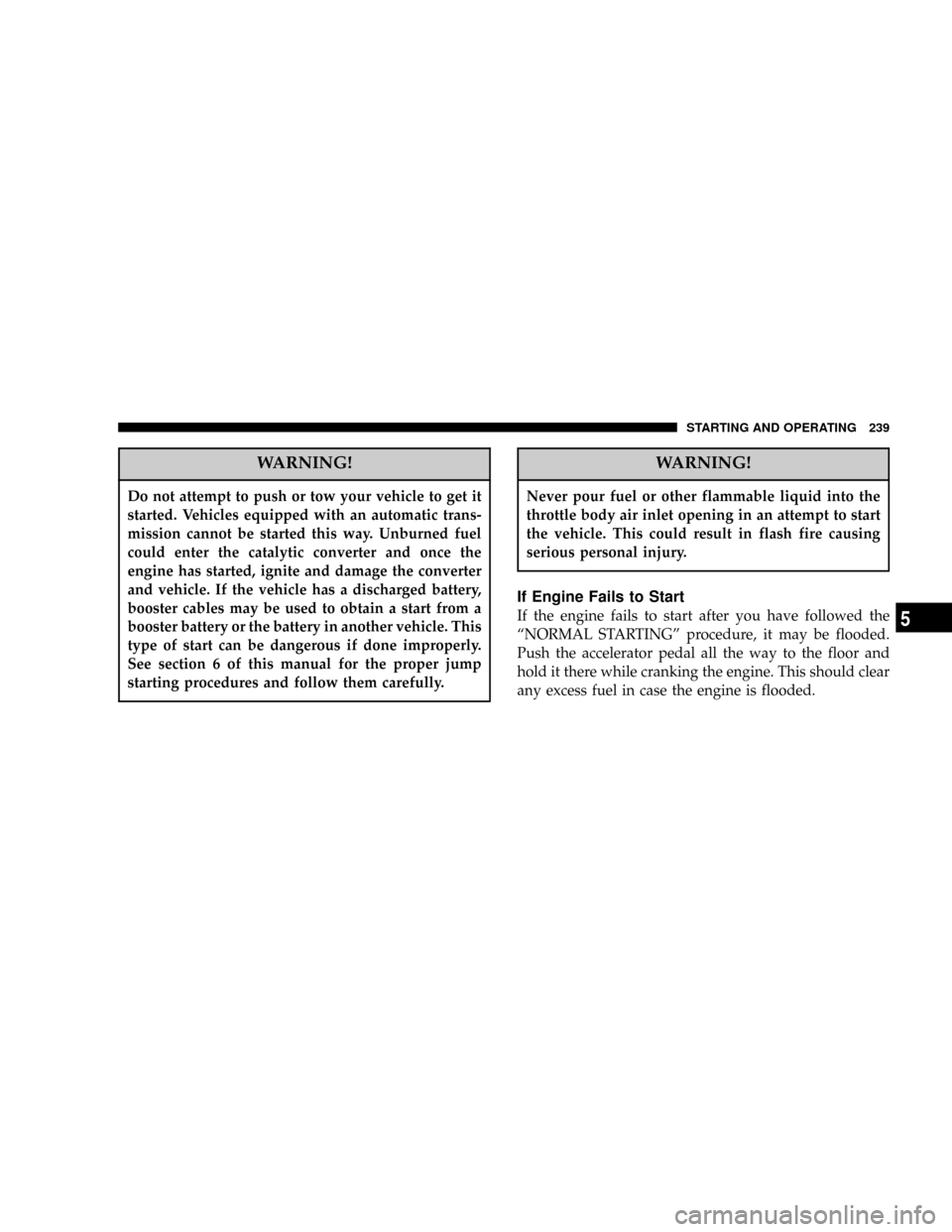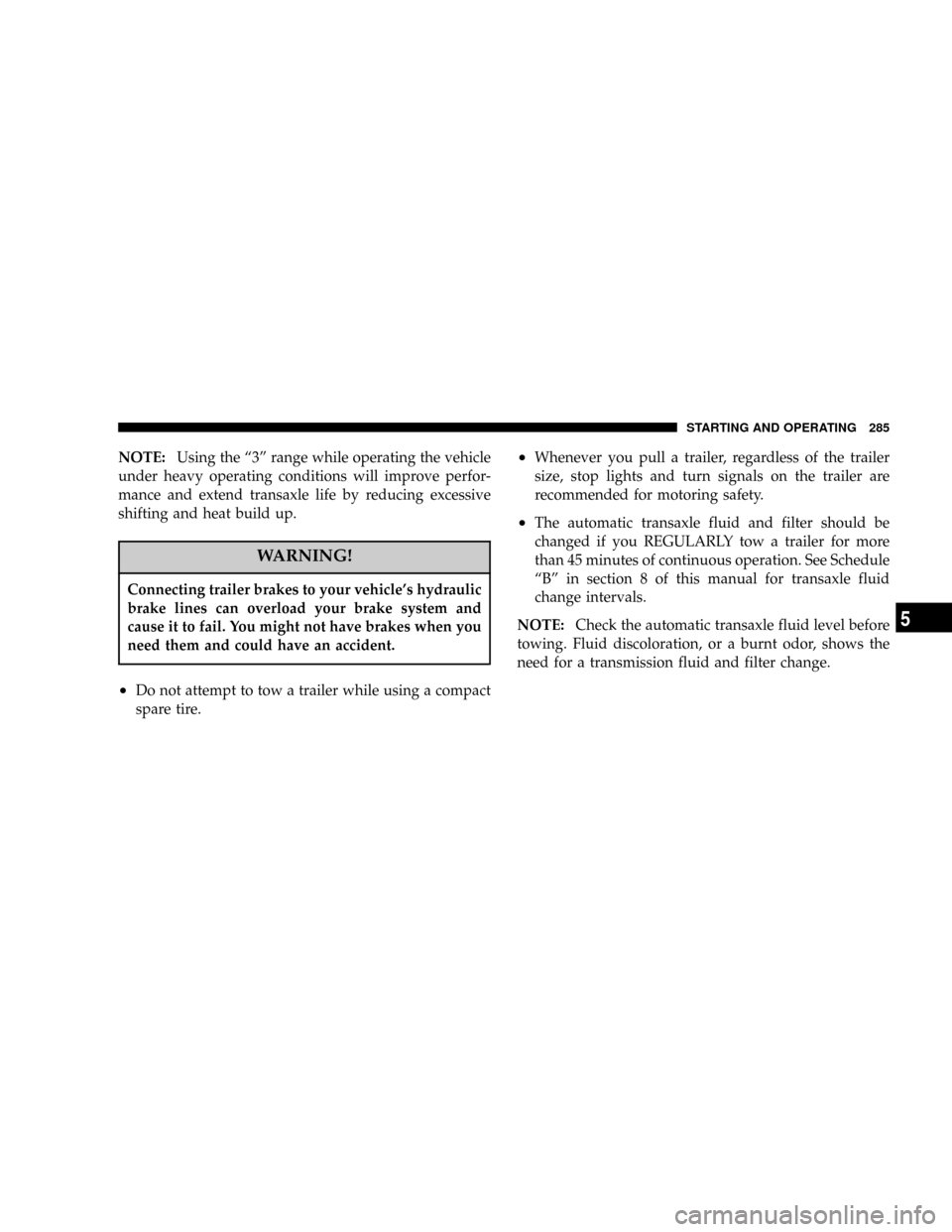tow CHRYSLER TOWN AND COUNTRY 2004 4.G Owner's Manual
[x] Cancel search | Manufacturer: CHRYSLER, Model Year: 2004, Model line: TOWN AND COUNTRY, Model: CHRYSLER TOWN AND COUNTRY 2004 4.GPages: 401
Page 239 of 401

WARNING!
Do not attempt to push or tow your vehicle to get it
started. Vehicles equipped with an automatic trans-
mission cannot be started this way. Unburned fuel
could enter the catalytic converter and once the
engine has started, ignite and damage the converter
and vehicle. If the vehicle has a discharged battery,
booster cables may be used to obtain a start from a
booster battery or the battery in another vehicle. This
type of start can be dangerous if done improperly.
See section 6 of this manual for the proper jump
starting procedures and follow them carefully.
WARNING!
Never pour fuel or other flammable liquid into the
throttle body air inlet opening in an attempt to start
the vehicle. This could result in flash fire causing
serious personal injury.
If Engine Fails to Start
If the engine fails to start after you have followed the
ªNORMAL STARTINGº procedure, it may be flooded.
Push the accelerator pedal all the way to the floor and
hold it there while cranking the engine. This should clear
any excess fuel in case the engine is flooded.
STARTING AND OPERATING 239
5
Page 243 of 401

possible convenience. Your dealer has diagnostic equip-
ment to determine if the problem could recur.
If the transmission cannot be reset, dealer service is
required.
Gear Ranges
DO NOT race the engine when shifting from PARK or
NEUTRAL positions into another gear range.
²ªPº Park
Supplements the parking brake by locking the transmis-
sion. The engine can be started in this range. Never
attempt to use PARK while vehicle is in motion.Apply parking brake when leaving vehicle in this range.
²ªRº Reverse
Shift into this range only after the vehicle has come to a
complete stop.
²ªNº Neutral
Engine may be started in this range.
²ªDº Overdrive
For most city and highway driving, it provides smoothest
upshifts and downshifts and best fuel economy. When
frequent transmission shifting occurs while using the
ªDº Overdrive position, such as when operating the
vehicle under heavy loading conditions, (i.e. in hilly
terrain, traveling into strong head winds or while towing
heavy trailers), using the ª3º position will improve
performance and extend transmission life by reducing
excessive shifting and heat build-up.
STARTING AND OPERATING 243
5
Page 246 of 401

added precaution, turn the front wheels toward the curb
on a downhill grade and away from the curb on a uphill
grade.
The parking brake should always be applied when the
driver is not in the vehicle.
WARNING!
Leaving children in a vehicle unattended is danger-
ous for a number of reasons. A child or others could
be injured. Children should be warned not to touch
the parking brake, brake pedal or the gear selector
lever. Don't leave the keys in the ignition. A child
could operate power windows, other controls, or
move the vehicle.
WARNING!
Be sure the parking brake is fully disengaged before
driving: failure to do so can lead to brake failure, and
an accident.
BRAKE SYSTEM
In the event power assist is lost for any reason (for
example, repeated brake applications with the engine
off), the brakes will still function. The effort required to
brake the vehicle will be much greater than that required
with the power system operating.
Your vehicle is equipped with dual hydraulic
brake systems. If either of the two hydraulic
systems lose normal capability, the remaining
system will still function. There will be some
loss of overall braking effectiveness. This may be evident
246 STARTING AND OPERATING
Page 257 of 401

Loading
The vehicle maximum load on the tire must not exceed
the load carrying capacity of the tire on your vehicle. You
will not exceed the tire's load carrying capacity if you
adhere to the loading conditions, tire size and cold tire
inflation pressures specified on the Tire and Loading
Information placard and the Vehicle Loading section of
this manual.
NOTE:Under a maximum loaded vehicle condition,
gross axle weight ratings (GAWR's) for the front and rear
axles must not be exceeded. For further information on
GAWR's, vehicle loading and trailer towing, see the
Vehicle Loading section of this manual.
To determine the maximum loading conditions of your
vehicle, locate the statement ªThe combined weight of
occupants and cargo should never exceed XXX kg or XXX
lbs.º on the Tire and Loading Information placard. Thecombined weight of occupants, cargo/luggage and
trailer tongue weight (if applicable) should never exceed
the weight referenced here.
Steps for Determining Correct Load Limit
1. Locate the statement ªThe combined weight of occu-
pants and cargo should never exceed XXX poundsº on
your vehicle's placard.
2. Determine the combined weight of the driver and
passengers that will be riding in your vehicle.
3. Subtract the combined weight of the driver and pas-
sengers from XXX kilograms or XXX pounds.
4. The resulting figure equals the available amount of
cargo and luggage load capacity. For example, if ªXXXº
amount equals 1400 lbs. and there will be five 150 lb.
passengers in your vehicle, the amount of available cargo
and luggage load capacity is 650 lb. (1400±750 (5 x 150) =
650 lb.)
STARTING AND OPERATING 257
5
Page 258 of 401

5. Determine the combined weight of luggage and cargo
being loaded on the vehicle. That weight may not safely
exceed the available cargo and luggage load capacity
calculated in step 4.
6. If your vehicle will be towing a trailer, load from your
trailer will be transferred to your vehicle. Consult this
manual to determine how this reduces the available
cargo and luggage load capacity of your vehicle.
NOTE:The following table shows examples on how to
calculate total load, cargo/luggage and towing capacitiesof your vehicle with varying seating configurations and
number and size of occupants. This table is for illustra-
tion purposes only and may not be accurate for the
seating and load carry capacity of your vehicle.
NOTE:For the following example the combined weight
of occupants and cargo should never exceed 865 lbs. (392
Kg).
258 STARTING AND OPERATING
Page 269 of 401

are significantly underinflated. It is particularly impor-
tant, therefore, for you to check the tire pressure in all of
your tires regularly and maintain proper pressure.
1,2,3, OR 4 TIRE(S) LOW PRESSURE
Low tire pressure levels of 28 psi [1.9 bars] (193 kPa) or
less detected in one or more tires.
Inspect all tires for proper inflation pressure, once proper
tire pressure has been set the TPM system warning will
reset automatically once ignition switch has been turned
ON.
1,2,3, OR 4 TIRE(S) HIGH PRESSURE
High tire pressure levels of 48 psi [3.3 bars] (330 kPa) or
more detected in one or more tires.
Inspect all tires for proper inflation pressure, once proper
tire pressure has been set the TPM system warning will
reset automatically once ignition switch has been turned
ON.
SERVICE TIRE PRESSURE SYSTEM/SEE
OWNER'S MANUAL
The Tire Pressure Monitor System (TPM) system requires
service.
See your authorized dealer for service.
TIRE PRESSURE UNAVAILABLE
The TPM system function is temporarily unavailable due
to external electromagnetic interference, such as portable
electronic devices, or near by radio or TV towers.
Move the vehicle to an area free from radio, TV antennas
and transmitting towers or disconnect any portable elec-
tronic devices, once the external interference is removed
the TPM system will resume normal operation and ªTIRE
PRESSURE NOW AVAILABLEº will appear in the over-
head console display.
STARTING AND OPERATING 269
5
Page 283 of 401

Overloading can cause potential safety hazards and
shorten useful service life. Heavier axles or suspension
components do not necessarily increase the vehicle's
GVWR.
Loading
To load your vehicle properly, first figure out its empty
weight, axle by axle and side by side. Store heavier items
down low and be sure you distribute their weight as
evenly as possible. Stow all loose items securely before
driving. If weighing the loaded vehicle shows that you
have exceeded either GAWR, but the total load is within
the specified GVWR, you must redistribute the weight.
Improper weight distribution can have an adverse effect
on the way your vehicle steers and handles and the way
the brakes operate.
A loaded vehicle is shown in the illustration. Note that
neither the GVWR or the GAWR capacities have been
exceeded.
Front
AxleRear Axle
Empty Weight 2140 lbs 1470 lbs
Load (Including driver, pass-
sengers and cargo)360 lbs 980 lbs
Total 2500 lbs 2450 lbs
GAWR 2544 lbs 2544 lbs
STARTING AND OPERATING 283
5
Page 284 of 401

TRAILER TOWING
In this section you will find safety tips and information
on limits to the type of towing you can reasonably do
with your vehicle. Before towing a trailer carefully re-
view this information to tow your load as efficiently and
safely as possible.
To maintain warranty coverage, follow the requirements
and recommendations in this manual concerning ve-
hicles used for trailer towing.
Perform maintenance services as prescribed in the main-
tenance schedules manual. When your vehicle is used for
trailer towing, never exceed the gross axle weight rating
(GAWR) by the addition of:
²The tongue weight of the trailer.
²The weight of any other type of cargo or equipment
put in or on your vehicle.
²Remember that everything put in or on the trailer adds
to the load on your vehicle.
Warranty Requirements
The Manufacturer's Passenger Vehicle Warranty will
apply to vehicles used to tow trailers for non-commercial
use. However the following conditions must be met:
²The maximum frontal area of the trailer cannot exceed
20 square feet (1.86 square meters).
²The trailer tongue load must be considered as part of
the combined weight of occupants and cargo, and
should never exceed the weight referenced on the Tire
and Loading Information placard. Refer to the Tire±
Safety Information Section in this manual.
²The ªDº range can be selected when towing. However,
if frequent shifting occurs while in this range, the ª3º
range must be selected.
284 STARTING AND OPERATING
Page 285 of 401

NOTE:Using the ª3º range while operating the vehicle
under heavy operating conditions will improve perfor-
mance and extend transaxle life by reducing excessive
shifting and heat build up.
WARNING!
Connecting trailer brakes to your vehicle's hydraulic
brake lines can overload your brake system and
cause it to fail. You might not have brakes when you
need them and could have an accident.
²Do not attempt to tow a trailer while using a compact
spare tire.
²Whenever you pull a trailer, regardless of the trailer
size, stop lights and turn signals on the trailer are
recommended for motoring safety.
²The automatic transaxle fluid and filter should be
changed if you REGULARLY tow a trailer for more
than 45 minutes of continuous operation. See Schedule
ªBº in section 8 of this manual for transaxle fluid
change intervals.
NOTE:Check the automatic transaxle fluid level before
towing. Fluid discoloration, or a burnt odor, shows the
need for a transmission fluid and filter change.
STARTING AND OPERATING 285
5
Page 286 of 401

TRAVEL CONDI-
TIONMAXIMUM TRAILER WEIGHT (TRAILER FRONTAL AREA NOT TO EXCEED 32
SQ. FT.)
3.3L,& 3.8L EN-
GINES WITH
4-SPEED AUTO-
MATIC TRANS-
AXLE3.3L & 3.8L EN-
GINES WITH
HEAVY DUTY
TRAILER TOW
PACKAGE3.8L ENGINES
WITH 4-SPEED AU-
TOMATIC TRANS-
AXLE3.8L ENGINES
WITH HEAVY
DUTY TRAILER
TOW PACKAGE
MAX. COMBINED
WEIGHT OF VE-
HICLE AND
TRAILER NOT TO
EXCEED 6,600 lbs
(2993 kg)MAX. COMBINED
WEIGHT OF VE-
HICLE AND
TRAILER NOT TO
EXCEED 8,600 lbs
(3900 kg)MAX. COMBINED
WEIGHT OF VE-
HICLE AND
TRAILER NOT TO
EXCEED 6,600 lbs
(2993 kg)MAX. COMBINED
WEIGHT OF VE-
HICLE AND
TRAILER NOT TO
EXCEED 8,600 lbs
(3900 kg)
FWD FWD AWD AWD
UP TO 2 PERSONS
& LUGGAGE1,800 lbs(816 kg ) 3,800 lbs (1723 kg) 1,550 lbs (703 kg) 3,550 lbs (1610 kg)
3 TO 5 PERSONS &
LUGGAGE1,350 lbs (612 kg) 3,350 lbs (1519 kg) 1,100 lbs (498 kg) 3,100 lbs (1406 kg)
6 TO 7 PERSONS &
LUGGAGE1,000 lbs (454 kg) 3,000 lbs (1360 kg) 750 lbs (340 kg) 2,750 lbs (1247 kg)
286 STARTING AND OPERATING